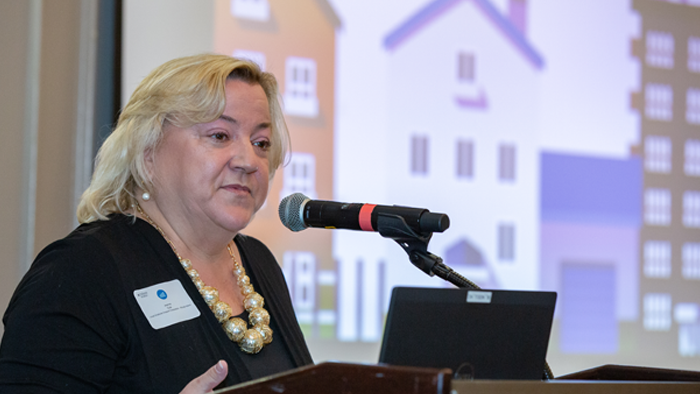Community Development Advance Eligibility
Discounted CDA funding helps members support economic development and mixed-use initiatives in their communities.
CDA funds can be used to provide financing for the purchase, construction, refinance, rehabilitation, and/or predevelopment financing of:
- Commercial initiatives, such as shopping centers, office buildings, hotels, and retail stores;
- Industrial and manufacturing initiatives, such as factories, bakeries, warehouses, and assembly plants;
- Public-facility initiatives, such as buildings and vehicles for police and fire departments;
- Social-service initiatives, such as office space for nonprofits, program facilities, hospitals, nursing homes (excluding assisted living facilities), and day-care centers;
- Public or private infrastructure projects, such as roads, sidewalks, utilities, and sewers.
Eligible Economic Development Initiatives
Project Type Eligibility Requirements:
Geographic Beneficiaries
Initiative is located in targeted geographic areas such as:
- A census tract with a median income at or below: 100% of the area median income in urban areas or 115% of the area median income in rural areas
- Brownfield
- Champion Community
- Empowerment Zone
- Enterprise Community
- A community affected by the North American Free Trade Agreement (NAFTA) as designated by the Community Adjustment and Investment Act (CAIP)
- Indian areas
- Area affected by the closing of a military base
- State-declared disaster areas (must be approved by the Federal Housing Finance Agency)
- Federally declared disaster areas
Activity Beneficiaries
Project qualifies as a small business, as defined by section 3(a) of the Small Business Act (15 U.S.C. 632(a) and implemented by the Small Business Administration under 13 CFR part 121, or any successor provisions.
Individual Beneficiaries
- The initiative creates or retains jobs, other than construction jobs, where the annual salaries for at least 51% of the permanent full- and part-time jobs, computed on a FTE basis, are income eligible; or
- The initiative primarily serves or benefits individuals or families that are income eligible.
“Income eligible” refers to workers, individuals, or households with incomes at or below 100% of the area median income if located in an urban area or 115% of area median income if located in a rural area.
Mixed-Use Initiatives
Project Type Eligibility Requirements:
Mixed-Use
Members may use CDA funds to provide financing for initiatives that involve a combination of economic development and affordable housing. To be eligible for such an advance, the economic development component of the initiative must meet at least one of the eligibility criteria for economic development initiatives, as shown above. There are no eligibility requirements for the housing portion of a mixed-use initiative.
Eligible Financing Activities
Members may use CDA funds to:
- Originate eligible loans;
- Fund eligible loans that were originated up to three months before receiving the CDA;
- Refinance eligible economic development initiatives;
- Make loans to entities that, in turn, make loans for eligible economic development initiatives; or
- Purchase a participation interest, or provide financing to participate, in a loan consortium for eligible economic development initiatives.
Note: Funding supporting the construction, refinance, or development of a marijuana dispensary business or a member facility (such as headquarters/branches) is NOT eligible for the CDA program.
Limits:
Each member will have access to fund a maximum annual CDA limit of $100 million. To ensure that each member will fund no more than $100 million in CDA funding during any one calendar year, each member’s CDA limit and approvals will be managed based on the following calculation:
CDA: $100 Million Member Funding Limit
- Less any unexpired approvals with an available for disbursement balance greater than $0
- Less CDA disbursements during current calendar year
- Less the total amount requested of any submitted (unapproved) CDA application(s)
The Federal Home Loan Bank of Boston reserves the right to further limit the total amount of CDA funding available or to limit the amount of CDA available per member without notice.
Application:
Members can apply online for a CDA through the Bank’s website at https://housing.fhlbboston.com. The Bank will review applications within 10 business days.
Available Products and Maturities:
CDAs are available in maturities of six months and longer. Three kinds of advances are always available: Classic, Member-Option, and Amortizing. Classic Advances are fixed-rate advances with interest due monthly and principal due at maturity. Member-Option Advances are fixed-rate advances that are repayable without fee on specified cancellation dates. Other prepayment structures may also be available. Amortizing Advances are fixed-rate advances with monthly payments of interest and principal. Other terms and maturities may be available upon request.
Forward Rate Commitment:
To guard against rising interest rates, members may purchase a forward rate commitment to lock in the current rate for disbursement on a future date. Members may call our Member Funding Desk at 800-3573452 for pricing information on forward rate commitments.
Take-Down and Disbursement:
Taking down a CDA is simple. Once the application is approved, the member calls
our Member Funding Desk to take down the funds.
Expirations:
Approvals for CDA expire six months from the date of approval. If a member is unable to take down a CDA within the specified take-down period, the member may submit a new application, provided that the funds requested are within their CDA limit availability.
Spread:
When making a loan using the funds from a CDA, the member’s spread on the loan may not exceed its standard spread on similar loans.
Reporting:
Applications approved under the CDA program are subject to the Federal Home Loan Bank of Boston’s “Beneficiary Eligibility” reporting requirement. Members can provide documentation supporting program eligibility at the time of application or after disbursement. Documentation is subject to review and confirmation of compliance by the Federal Home Loan Bank of Boston.
Income Eligibility:
For loans qualified by income, the household income must be at or below 115% of area median
income for a rural initiative or 100% of area median income for an urban initiative for a family of four based on the income guidelines as published annually by HUD. For loans qualified by income for the location, the census tract in which the property is located must be at or below 115% of area median income for a rural initiative or 100% of area median income for an urban initiative for the area as determined using www.ffiec.gov for the address or census tract.
Geographic Beneficiary
Below are the definitions of the geographic beneficiary areas that are eligible for CDA funding.
Income-Eligible Neighborhood
An income-eligible neighborhood is defined as a census tract in which the median family income is at or below 115% of area median income for a rural initiative or 100% of area median income for an urban initiative for the area. The Bank uses www.ffiec.gov to determine the eligibility of each address or census tract.
Champion Community
A Champion Community is a community that developed a strategic plan and applied for designation by either the Secretary of HUD or the Secretary of the
United States Department of Agriculture (USDA) as an Empowerment Zone or Enterprise Community but was designated a Champion Community.
Empowerment Zone
An Empowerment Zone is an area so designated by either the Secretary of HUD or the Secretary of the USDA.
Enterprise Community
An Enterprise Community is a community so designated by either the Secretary of HUD or the Secretary of the USDA.
Community Adjustment and Investment Program (CAIP) Area
A CAIP area is an area that has experienced significant job losses as a result of increased imports from Canada and/or Mexico following the implementation of
the North American Free Trade Agreement (NAFTA). These communities receive financial and technical assistance from USDA and SBA.
Brownfield
A brownfield is an area that involves a property eligible for a Brownfield Tax Credit.
Indian Area
An Indian area is an area defined by the Native American Housing Assistance and Self-Determination Act of 1996 (25U.S.C. 4101et seq.).
Area Affected by Military Base Closure
The area is a “community in the vicinity of the installation” as defined by the Department of Defense at 32 CFR Part 176.
Federally or State-Declared Disaster Area
The area has been declared a disaster area by either the federal or state governments.
Activity Beneficiary
The initiative qualifies as a Small Business.
For a small business to be eligible it must qualify as ‘small business concern’ as that term is defined by section 3(a) of the Small Business Act (15 U.S.C. 632(a) and implemented by the Small Business Administration under 13 CFR part 121, or any successor provisions. Please refer to www.sba.gov for further SBA eligibility guidance.
Individual Beneficiary
The initiative creates or retains jobs for income-eligible workers.
At least 51% of the permanent full- and part-time jobs, computed on a full-time-equivalent basis, created or retained by the initiative, other than construction jobs, must be at or below 115% of area median income for a rural initiative or 100% of area median income for an urban initiative.
The initiative benefits income-eligible families.
At least 51% of the families who benefit from (other than through employment), or are provided services by, the initiative must have incomes at or below 115% of area median income for a rural initiative or 100% of area median income for an urban initiative.
Ready to Apply?
Members can log in and apply here:

